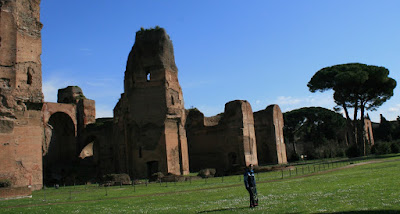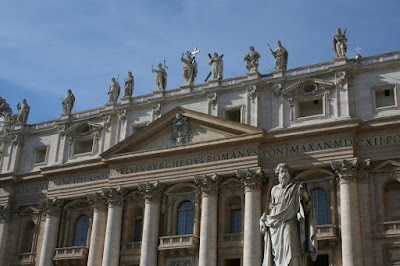Friday, May 29, 2009
Munchen
I leibe Munich!
The Vatican
 This fiefdom of the Papacy is a shockingly impressive place. Approaching the vast Square of St Peter, you witness an architectural illusion. Much like the Taj Mahal, the conceptual balance of the place hides its scale – it can accommodate 250,000 worshippers. Only as you approach St Peter's Basilica itself does the vastness of the surroundings take hold.
This fiefdom of the Papacy is a shockingly impressive place. Approaching the vast Square of St Peter, you witness an architectural illusion. Much like the Taj Mahal, the conceptual balance of the place hides its scale – it can accommodate 250,000 worshippers. Only as you approach St Peter's Basilica itself does the vastness of the surroundings take hold.
St Peter's Basilica
This immense building completed in 1626 after more than a century in the making (and arguably a religion in the splitting – but that is another story) is the largest Church ever built. How do you get more imposing than that? I'll tell you how, by having every square inch intricately decorated. Decked with grand paintings, searing marble pillars and gold gilt carvings. For all this, I did not find it an inspiring space. Quite different to the square outside, the scale and effect is diminished by an almost tacky display of wealth (and power). It lacks the serene simplicity that man at his best can capture. All in all too gaudy for my tastes.
 On departure, I distinctly remember golden light sheering across the high innards of St Peter's. I'll reassess another day.
On departure, I distinctly remember golden light sheering across the high innards of St Peter's. I'll reassess another day. Back into the hustle and bustle of Rome…we'll talk politics another day.
Back into the hustle and bustle of Rome…we'll talk politics another day.Morning
Up at first light in London. Something distinctly rare in my little world. Still up at dawn maybe, but this way round…..its never been me.
A few surprises. The streets are empty. Less hustle, bustle and stress. A beautiful, bright day. The sun creeping up beyond Tower Bridge, burning away the haze which rises from the river and obscures the Wharf. Day after day, watching the myriad of skies from London Bridge - a simple private pleasure of life.
A Sublime tune, one smile from a lady at Mr Coffee and the day doesn't look so bad. Just another day. The wheel turns.
Tuesday, May 12, 2009
Tuesday, May 05, 2009
Roman Rome
 The legacy and aftermath of what originated around these sacred hills have helped to shape Euopean history for over two millenia. Not only in empire building, politics and military strategy, but in law, language, religion and much else. Quite simply, without Rome the concept of our current European society is unthinkable.
The legacy and aftermath of what originated around these sacred hills have helped to shape Euopean history for over two millenia. Not only in empire building, politics and military strategy, but in law, language, religion and much else. Quite simply, without Rome the concept of our current European society is unthinkable.Even the Pope still litters Rome with his proud title P.M. - Pontificus Maximus - a pagan title once held by Julius Ceasar himself.
Skeletal Relics
But what is left of Roman Rome? The answer is more than you can take in and far more yet undiscovered below and within the modern breathing Rome. We saw one fascinating example of a central villa that had been excavated to its foundations. Every era had left its mark and Rome formed the base.
Rambling around the city you bump into magnificent relic after magnificent relic. The city abounds such with privileged remains that after only a few days, coming upon a mighty two thousand year old structure can become the accustomed norm. In spite of this, the sight of certain architectural gifts Rome left to the world can never become common place.
The Pantheon
Straight to what was, for me, the most impressive monument of Roman Rome. From the outside it is quite a sight, with its circular brick construction and looming mighty pillars set off by the most pretty of little squares. This did not prepare me for the inside. I’m not sure what I expected, but on entering my jaw dropped. A moment of delusion and excitement.

The simple beauty, scale and achievement of the Pantheon left me aghast. In a perfect circle walls rise high above, indented by porticoes that once housed the pantheon of Roman Gods and now Saints of Catholicism. Set on top of this is the largest stone vault ceiling ever constructed. Scale is lost. I had to pinch myself. In the optical illusion of such symmetry, only the knowledge that the "small" circular hole at the pinnacle of the roof was 8 metres in diameter gave me scale. Astounding.
Completed 1883 years ago, it is a testament to Roman ingenuity and engineering prowess that it still stands – but more of that later…
Coliseum
Everyone else's favourite. Within a couple of hours we saw this monolithic relic of classical entertainment – the battle and slaughter of men and wild beasts – under a sky of four seasons. Whether under drizzle, glorious sunshine or plummeting hail (see "all hail" video) it is indeed a wonder of the world.
 Yet again the combination of scale and detail. The eye wonders down from the three-tiered seating (originally capable of seating as many as St James’ Park), to the bowels of beast, the intricate passageways, cells and stores of the foundations.
Yet again the combination of scale and detail. The eye wonders down from the three-tiered seating (originally capable of seating as many as St James’ Park), to the bowels of beast, the intricate passageways, cells and stores of the foundations.Circus Maximus and Baths
From one stadia to another. Little remains of the grand racetrack except for an elliptical shaped park frequented by leaking dogs. That said, we had to have a little sprint around, soaking up the resonance (and other things) from the soil.
Nearby however, the Baths of Caracalle are a different story. Much still stands of the huge bathing complex and you get a real feel of how seriously the Romans took this leisurely activity. There were outdoor pools, hot baths, cold baths, a gym, sauna and even a library.
 One indicator of the success of a civilization is its ability to provide for its people. Rome not only managed to provide sustenance, but leisure on a mass scale. I suppose you can look at this like profit from a corporate – the Romans advanced far beyond simply staying afloat. From watching the games to going to the gym and socialising in the gardens of the bath, it took nigh on 1500 years for civilisation to provide more for the masses.
One indicator of the success of a civilization is its ability to provide for its people. Rome not only managed to provide sustenance, but leisure on a mass scale. I suppose you can look at this like profit from a corporate – the Romans advanced far beyond simply staying afloat. From watching the games to going to the gym and socialising in the gardens of the bath, it took nigh on 1500 years for civilisation to provide more for the masses.Palatine to Capitoline
Immediately outside the Coliseum stands the intricately carved victory arch of Constantine. Past this and through a gate you climb the Palatine hill. Atop are remains of great palaces. It is easy to think of Roman civilisation as one entity in time, but of course it is a series of peaks and troughs of mini civilisation. This is evident on the hill, where palaces from different era are built on top of each other. The palace of Augustine was most impressive with its huge multi-layered halls.
 Across the hill and behold, the original Roman forum opens up in front of you. One of the great city vistas, a multitude of Roman remains and the modern city rising up beyond. It took my breath away!
Across the hill and behold, the original Roman forum opens up in front of you. One of the great city vistas, a multitude of Roman remains and the modern city rising up beyond. It took my breath away! 
 The density of impressive ruins is startling. As you walk down the forum you are surrounded by temples, great ceremonial arches, places of business and government. Far too much to take in at one time and this is only one forum. Those of later emperors lie across the main road – depending on how you look at it, Mussolini’s traffic relieving necessity or an archeological violation. A problem inherent with Rome’s great past and present. The balance between glorifying and maintaining that of those dead and allowing the present metropolis to breath.
The density of impressive ruins is startling. As you walk down the forum you are surrounded by temples, great ceremonial arches, places of business and government. Far too much to take in at one time and this is only one forum. Those of later emperors lie across the main road – depending on how you look at it, Mussolini’s traffic relieving necessity or an archeological violation. A problem inherent with Rome’s great past and present. The balance between glorifying and maintaining that of those dead and allowing the present metropolis to breath.Rising up above the focus of the forum is an example of where this balance has been marvellously maintained – the Capitoline hill. Seat of the rulers of the city from antiquity to this day, the current Mayor’s office exposes the history of the sight in its multi-era layered walls. An evocative sight.
Focus to finish
Of the multitude of historical facts, stories and anecdotes we came across while in Rome, I wish to end this reflection with one particular tale of power and possession that, for me, bought the place to life. This story connects two prominent monuments (the Pantheon and a free standing column at the epi-centre of the Roman forum) and two figures of authority (the Pope and the Emperor at Constantinople).
The first thing that struck me when I entered the Pantheon was how intact it was and the first questioned I asked myself was "why?". The answer apparently lies in an early 7th century emperor’s reassertion of power over Rome. For hundreds of years the eastern emperors laid claim to Rome as the genuine inheritors of Roman imperial power. During a short period of reassertion of power in the early 7th century, the emperor concerned wished to raise himself beside the great Roman emperors of times past. He wished to have built a great pillar at the centre of the old Roman forum and place a statue of himself at the top.
 Perhaps a symbol of insecurity of a man who was famous for having ‘risen through the ranks’.
Perhaps a symbol of insecurity of a man who was famous for having ‘risen through the ranks’. The problem, the Pope had effective control of the city. The solution, a deal. An agreement was struck that the emperor concerned could have his status symbol if the church could have Pantheon. And so, one of the great buildings of the world was up kept for posterity and the emperor’s name went down in history. He was called Phocus and thence came the term ‘focus’.
I leave gob-smacked in awe at what once was and what remains.


